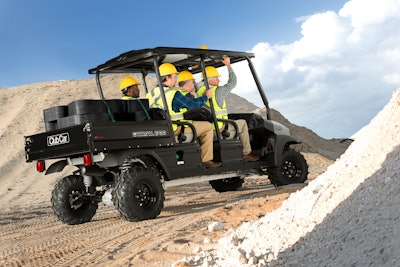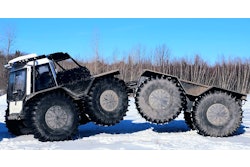
When it comes to utility vehicles, rental houses often worry if they carry them and worry if they don’t.
Historically, many UTVs have been difficult to maintain and backed by poor support services. On the other hand, construction companies are demanding today’s more powerful UTVs to replace expensive pickup trucks.
So what’s the solution?
Mike Holderfield, a service technician with Club Car’s dedicated rental team, shares his insights on how to navigate that dilemma and buy vehicles that will keep your mechanics happy and give renters what they want.
“There are big differences in various models of utility vehicles,” Holderfield says. “And the devil is in the details.”
Key Factors
According to Holderfield, the three key factors rental houses should consider when buying UTVs are build-quality, ease of serviceably and quick, efficient support.
Holderfield also notes that contractors tend to prefer four-passenger, diesel vehicles. “Four-passenger vehicles with extended beds reduce overall costs because they can carry two crews and their gear, yet they are only a little more expensive than two-passenger vehicles,” he says.
Don’t waste your money on playthings
Many UTVs sold into the rental market are not engineered and built for heavy work environments. They are actually recreational vehicles sold into the rental market. These vehicles are also unsafe on worksites, as they may reach speeds as high as 50 mph. That’s just asking for trouble.
“Look for vehicles that are purpose-built for work from the ground up, and check the hauling and bed capacity,” Holderfield says. “Neither converted golf cars nor recreational vehicles have the frames and suspension systems to handle rugged jobs or carry heavy loads. Tough work sites put them out of commission, and fast.”
Vehicles with four-link semi-independent rear suspension systems are generally the best choice for contractors. They combine independent system performance with solid-axle strength. “The solid axle is the world standard for Jeeps, LandRovers and Rock Crawlers,” says Holderfield.
These vehicles maintain their axle ground clearance and deliver a smooth ride even when fully loaded on rough terrain. “Vehicles with poor suspension systems carry much less weight and are easy to damage,” Holderfield says.
He also recommends buying vehicles built on strong aluminum frames that will not rust in wet or corrosive environments.
Most UTVS are built on steel frames, then coated to help prevent rust. However, the undersides of the frames are not coated and the frames can be scratched, allowing rust to get a foothold. “Rust can literally destroy your investment,” Holderfield says.
“Well designed aircraft-grade aluminum frames resist impact better than steel frames, and they are rustproof and corrosion resistant. They are also lighter, so you can deliver more vehicles at a time,” Holderfield says.
Think about serviceability to cut maintenance costs
Service can be a big problem with UTVs on construction sites. “Buy vehicles that are designed for easy serviceability from the top down, so there’s little need to go under the vehicle or remove components,” Holderfield says.
He also suggests you check the belt-driven continuously variable transmission (CVT) to make sure the units are shrouded or sealed to keep dirt out. Find vehicles with clean, unobstructed air intake to reduce maintenance, prevent clogging and extend engine life. Look for cars with self-cleaning driven clutches and drive clutches that self compensate for wear and don’t require maintenance or annual cleaning or adjustments.
Check the brakes for easy serviceability. Brakes with two reinforced rubber brake lines allow the lines to be replaced independently and reduce costs. Look for sectional booted brake cables for easy replacement.
“Make sure there is an independent park brake with multiple catches that self-compensate for cable stretch and brake wear. And there should be one single adjustment point that’s accessible from the top of the vehicle,” Holderfield says.
Finally, the vehicles should be protected with loud back-up alarms, heavy-duty skid plates and belly pans and aluminum front CV boot guards.
Reduce downtime with a dedicated rental support team
All manufacturers claim to deliver quick support and service, but few have the infrastructure to deliver on those claims, especially companies that make their vehicles abroad.
“Poor service may be the single biggest issue with rental UTVs,” Holderfield says. He advises you to partner with a manufacturer with a dedicated rental support team that works exclusively with rental customers and serves as a single point of contact for all your needs. “Without this, you’re liable to suffer expensive downtime and long waits for parts and service.”
“When you call for service, many companies will send you from department to department to get the help you need,” Holderfield says. “But a good rental team offers easy phone access to technicians who are experts in all aspects of the vehicles and can troubleshoot issues remotely and on site.”
Also ask about training. Find a manufacturer that operates regional and on-site classroom and hands-on training for mechanics.
Prevent damage with automatic four-wheel drive systems
“Ease of operation is the most important thing to consider in 4x4s. The easier the vehicles are to operate, and the fewer moving parts they have, the less chance of damage and expensive repair costs,” Holderfield says.
Holderfield recommends UTVs with automatic four-wheel drive systems. “These fool-proof systems sense the ground they’re on and shift as needed. Drivers don’t have to pull levers and push buttons. The system does the thinking for them,” he says
Users love automatic 4x4s because the vehicle knows it’s in trouble before the operator does. And there’s virtually no driver training needed.
“You’ll love them because there are fewer moving parts to damage and repair, less wear and tear and longer life,” Holderfield say.
Consider the warranty a statement of confidence
A strong warranty indicates the trust a manufacturer has in its products, particularly those sold into the rental market. “Some rental-ready UTVs carry no warranty at all. The best carry a two-year warranty in the rental market. That alone can save you thousands of dollars,” Holderfield says.
And, since UTVs are often the first equipment rented on construction sites, they can open doors to bigger contracts downstream.


















